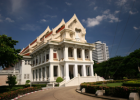About Taipei, TAIWAN
| A Quick Look at Taiwan | |
| Land Area | 36,000 square kilometers |
| Population | 23 million |
| Capital City | Taipei |
| People | Ethnic Chinese / Taiwanese / Aboriginal Asian |
| Languages | Mandarin (Chinese) / Taiwanese / Hakka / Aboriginal Dialects / English |
| Religions | Buddhism / Taoism / Christianity / Islam |
Taiwan, the Republic of China, is geographically situated at the point where the Asian continental shelf meets the vast Pacific Ocean. First known to the West as Ilha Formosa, or Beautiful Island, Taiwan’s unique geology and topography has given rise to the beautiful landscapes and coastal scenes that can be found all over the country.
In the last few decades, Taiwan has successfully developed itself to become a technological island, initially as an original equipment manufacturer, and today, as the source of world renowned brands such as Acer, Asus and HTC. Many visitors are surprised to find that despite the technological development and advancements it has achieved, the modest island of twenty three million people has managed to preserve not only a wide array of its ecological resources, but also its culture and traditions.
The government has established seven national parks and thirteen national scenic areas to preserve Taiwan’s natural ecological environment and cultural sites. Take a hike in the splendor and sheer heights of the cliffs at Taroko Gorge; take a ride on the Alishan train – one of only three mountain railways in the world – and experience the breathtaking sunset and sea of clouds; hike up to the summit of Northeast Asia’s highest peak, Jade Mountain. You can also soak up the sun in Kending, Asia’s version of Hawaii; stand at the edge of Sun Moon Lake; traipse through the East Rift Valley; or visit the offshore islands of Kinmen and Penghu. It’s fun and awesome journey of natural discovery!
The cultural aspects are also not to be missed. The blending of Hakka, Taiwanese, and ethnic Chinese cultures has produced a rich plethora of cultural and social color. Whether it is religion, architecture, language, living habits, or food, it’s just one big exciting melting pot! Food is the best representative of this cultural mixing and matching. Aside from cuisines from different parts of the mainland such as Zhejiang, Hunan, Guangdong, Yunnan, Shanghai, Beijing, Sichuan, and others, there is also local Taiwanese cuisine as well as local delicacies from various areas of the island.
Taiwan’s strategic location in Asia makes it an ideal gateway to the rest of the region. Many airlines fly directly to Taiwan, making it a perfect travel destination.
Climate
Taiwan enjoys warm weather all year round. The strongest fluctuations in weather conditions occur during spring and winter, while the weather is relatively stable during summer and autumn. Taiwan is an ideal travel destination since the annual average temperature is a comfortable 22 degrees Celsius with lowest temperatures ranging from 12 to 17 degrees Celsius (54-63 degrees Fahrenheit). With the exception of a few mountain areas where some traces of snow can be found during winter, snow is seldom seen in Taiwan. When summer approaches (March to May), continuously drizzling rain will sometimes fall on Taiwan while typhoons are known to reach the island during summer (June to August) so it is best to remember to carry an umbrella at all times.
Language
The official language of Taiwan is Mandarin (Chinese), but because many Taiwanese are of southern Fujian descent, Min-nan (the Southern Min dialect or Holo) is also widely spoken. The smaller groups of Hakka people and aborigines have also preserved their dialects. Many elderly people can also speak some Japanese because before the return of Taiwan to Chinese rule in 1945, they were subjected to Japanese education as a result of the Japanese occupation, which lasted for half a century.
The most popular foreign language in Taiwan is English and it is part of the regular school curriculum. However, to be on the safe side, it is advisable to prepare a note with basic phrases and particular places of destination, such as the school, or your living quarters written in Chinese so that people can assist you if needed.
Above information and photos are courtesy of the Taiwan Tourism Bureau, MOTC, R.O.C., please visit their website to learn more about Taiwan. www.taiwan.net.tw
Life in Taipei City
Taipei is a lively and diversified modern cosmopolitan metropolis serving as Taiwan’s economic, political and cultural center. Its buildings provide much architectural splendor and visitors who are fond of historic sites and old streets will not want to miss the work of traditional master builders evident on Dihua Street in the Dadaocheng area or the Longshan Temple in the Wanhua district. The internationally renowned National Palace Museum has an inexhaustible collection of precious historical Chinese arts and artifacts that no visitor can afford to miss; Taipei is also home to many other fine museums such as the Taipei Fine Arts Museum, National Museum of History, and the Postal Museum. On the city’s outskirts is the Yangmingshan National Park, which features a unique volcanic terrain, a rich variety of forest vegetation, and an extensive network of hiking trails; Yangmingshan is one of the few places in the Taipei area where you can indulge yourself in a hot mineral bath, making it a popular destination for visitors, whether they are seeking physical activity or relaxation. Taipei also has the largest zoo in Taiwan, you can see the rare Formosan black bear, the giant pandas, cuddly koalas, and stately king penguins in this zoo. The city’s comprehensive rapid transit system takes you quickly to the zoo or just about any place you might want to go in the metropolitan area.
Above information and photos are courtesy of the Taiwan Tourism Bureau, MOTC, R.O.C., please visit their website to learn more about Taiwan. www.taiwan.net.tw









